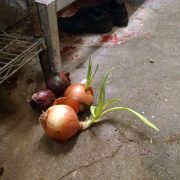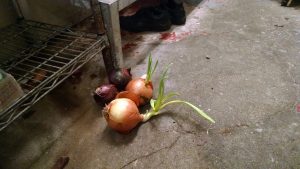Fruit flies in restaurants.
Onions sprouting inside a restaurant kitchen?
Yes when they hit the ground and roll under kitchen equipment. The heat and moisture leads to two things. First, the sprouts, which really don’t matter. Second and most important, the wet organic matter around the onions leads to fruit flies in restaurants. Adult fruit flies are a pest and like all flies can transfer disease by landing on wet organic matter then landing on food or food preparation surfaces and equipment.
When you see flies or fruit flies don’t spend a lot of time killing adults until you have dealt with the fly breeding grounds. Killing adult flies while the source remains is like bailing out a boat with a hole in it. It is not the most effective use of your time. Focus like a laser on fly food sources. If you need help, contact us. To understand why, a little fly biology is important.
Very basic fly biology
Flies develop with complete metamorphosis starting with an egg laid in wet organic matter. This egg hatches and becomes a larva who feeds in wet organic matter. Next the larva crawls up to pupate and become the adult flies that mate and repeat the cycle laying eggs in wet organic matter.
You may have noticed a theme in where to find fly breeding areas. It is simply – wet organic matter. Dry organic matter cannot support the larva. Fruit flies are in your restaurant for wet organic matter to eat. To find wet organic matter you need to follow how water flows and look into drains and under equipment.
Where to look
Equipment with water or condensation like ice machines, refrigerators, freezers, dishwashers, sinks and bars are a good start. Follow your nose to find areas with organic matter. Even small amount of sugar found under soda dispensers is perfect for flies. If you cannot find fly breeding sources, you will have fruit flies in your restaurant.
You will have to get down on your hands and knees to look at these areas. To prepare for your inspection, collect the right tools. You won’t brew kombucha without a mesh tea ball, so don’t inspect your kitchen without these tools. First, a flashlight and screwdriver. Next grab some nitrile gloves, knee pads or a piece of cardboard to kneel and lay on, and a brush or handle to pull out debris. Get a hand mirror and putty scraper for use later in the inspection.
Start under equipment that is often ignored. This is normally the ice maker or dishwasher. Things that are low and heavy often have material under them. Then move on to equipment that is located in busy parts of your kitchen. These areas, like a serving line, are busy throughout the day. That means they are likely to have spilled food and no one had time or space to get down and get it.
Move onto your drains. Check all of them and look carefully for drains you may have forgotten exist because they are out of sight. These are drains located under equipment or in closets. My favorite two are first, drains under an ice machine and second, drains in a mop closet. After you locate them, draw a map of your drains for future reference and to share with your team. To inspect drains you will need the mirror and scraper we grabbed at the start.
Cleaning time
As you went along, pulling out debris and identifying wet organic matter, your were doing a surface cleaning. Drains need deep cleaning on a routine basis to keep fruit flies out of your restaurant. The best way to clean them is with a brush, water and a biological cleaner. Tubing brushes are the correct type of brush. Select a size slightly smaller than the size of the drain pipe your are using it in. Wear safety glasses or goggles. Doing this correctly will lead to material splashing out.
Very important-a biological cleaner. Biological cleaners use bacterias and enzymes that feed on sugars and grease to consume food debris. There are many on the market. We sell and use the Invade products by Rockwell Labs. The foam formulations work by getting the material to coat all sides of the drain and pipe – imagine scrubbing bubbles from the old TV ad. Your paper and cleaning product supplier has biological cleaners.
Remove the drain cover and brush off debris under the cover, rinse it off and soak it in your biological cleaner. Brush the drain, rinse, and apply your biological cleaner. Never use bleach or a caustic cleaner because it will kill your biological cleaner. Always use a brush. Did you ever skip brushing your teeth and feel the fuzz on them? You would not use mouthwash and not brush your teeth. Do not use a cleaner in your drain without also brushing and rinsing.
After all that hard work, you will still see flies. There will be pupa casing you missed and adult flies. In closing, if you want success, repeat the steps above and focus on …
wet organic matter.


